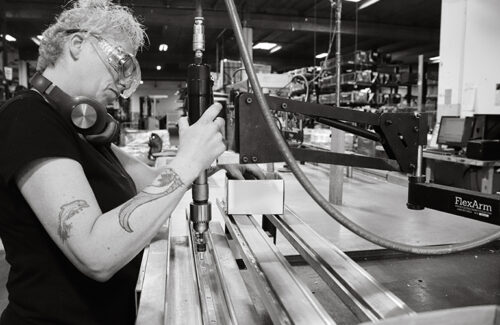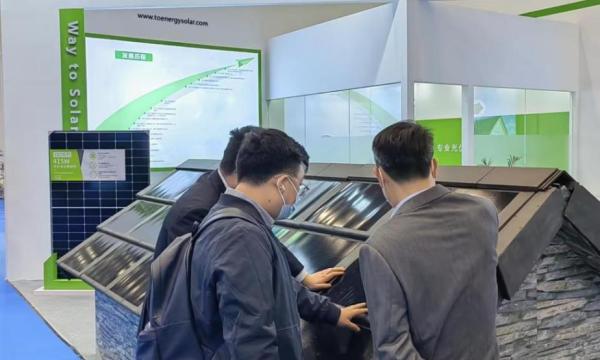建筑集成光伏被描述为无竞争力的光伏产品试图推向市场的地方。柏林Helmholtz-Zentrum的PVcomB的技术经理兼副总监BjörnRau说,但这可能是不公平的。Rau认为,BIPV部署缺少的链接在于建筑界,建筑业和PV制造商的交集。

位于瑞士苏黎世的多户住宅,其立面和屋顶采用集成式彩色PV,由KämpfenfürArchitektur设计和规划。
图片:KämpfenfürArchitektur
摘自PV杂志
在过去十年中,PV的快速增长达到了每年安装的约100 GWp的全球市场,这意味着每年生产和销售约350至4亿个太阳能模块。但是,将它们集成到建筑物中仍然是一个利基市场。根据欧盟Horizon 2020研究项目PVSITES的最新报告,2016年仅约2%的已安装PV容量被集成到建筑表皮中。当认为70%以上的能源消耗时,这一微不足道的数字尤其引人注目。世界范围内生产的二氧化碳都消耗在城市中,所有温室气体排放中约有40%到50%来自城市地区。
为了应对这一温室气体挑战并促进现场发电,欧洲议会和理事会于2010年引入了关于建筑物能源性能的指令 2010/31 / EU,其概念为“近乎零能耗的建筑物(NZEB)”。该指令适用于2021年以后建造的所有新建筑物。对于要容纳公共机构的新建筑物,该指令已于今年年初生效。
没有指定要达到NZEB状态的具体措施。建筑业主可以考虑能源效率的各个方面,例如保温,热回收和节电概念。但是,由于建筑物的整体能量平衡是监管的目标,因此,要达到NZEB标准,建筑物内或建筑物周围的有功电能生产必不可少。
潜力与挑战
毫无疑问,PV的实施将在未来建筑物的设计或现有建筑物基础设施的改造中发挥重要作用。NZEB标准将是实现这一目标的一个驱动力,但并不孤单。建筑物集成光伏(BIPV)可用于激活现有区域或表面以生产电力。因此,不需要额外的空间即可将更多的PV带入市区。集成光伏发电产生的清洁电力潜力巨大。正如Becquerel研究所在2016年发现的那样,德国的BIPV发电在总电力需求中的潜在份额超过30%,对于更多的南部国家(如意大利)甚至约为40%。
但是,为什么BIPV解决方案在太阳能业务中仍然只发挥边际作用?迄今为止,为什么很少在建设项目中考虑它们?
为了回答这些问题,德国Helmholtz-Zentrum柏林研究中心(HZB)去年组织了一次研讨会并与BIPV所有领域的利益相关者进行了交流,从而进行了需求分析。结果表明,并不是缺乏技术本身。
在HZB研讨会上,来自建筑业的许多人都在执行新建或翻新项目,他们承认在BIPV的潜力和支持技术方面存在知识差距。大多数建筑师,规划师和建筑所有者根本就没有足够的信息将光伏技术集成到他们的项目中。结果,对BIPV的保留很多,例如诱人的设计,高昂的成本以及令人望而却步的复杂性。为了克服这些明显的误解,必须将建筑师和建筑商所有者的需求摆在首位,并且将对这些利益相关者如何看待BIPV的理解作为重点。
功能与风格
BIPV的特征在于,太阳能模块是建筑表皮不可或缺的一部分,因此成为多功能建筑元素。除了发电以外,该模块现在还必须承担建筑外墙的其他功能。
该图(右)说明了不同类型集成的一些示例。显然,传统屋顶装置的最知名替代品是太阳能模块,该太阳能模块在功能上和美学上都直接集成在屋顶上。因此,这些模块不仅可以发电,而且还可以充当屋顶,以防风雨。如果可见,则在倾斜的屋顶情况下,太阳能组件也会影响建筑物的外观。常规屋顶元件的多样性还需要形状,颜色和外观具有高度可变性的PV有源元件。需要大面积,均质的玻璃-玻璃模块,以及小型系统,例如屋顶瓦片,其形状和颜色与常规屋顶瓦片完美匹配。
类似的标准对于用作外墙元素的太阳能组件也有效,但是在这里,美学品质尤为重要。有各种类型的PV活性立面。作为通风冷立面安装的太阳能模块可以很容易地替换通风幕墙的传统元件。但是也可以将解决方案用作温暖的立面元素,例如直接粘贴到立面上。除了具有防风雨功能外,隔热层或隔音层是PV主动立面元素可以提供的其他属性。
关于立面元素的美学功能,市场上已经有不同的概念。彩色模块的范围从无烟煤/黑色到灰色,蓝色,绿色,黄色甚至“金色”。例如,可以通过使用包含纳米层结构的特殊前玻璃来实现这些颜色。重要的是,这种类型的模块的功率输出不会被过分降低,与具有透明前玻璃的传统模块相比,其初始功率输出可达到80%以上。
替代使用这种特殊的前玻璃是陶瓷印刷。该技术实现了均匀的颜色以及架构师喜欢的另一个功能:可以在模块顶部打印几乎任何结构或图片的潜力。实际上,此功能可使观察者几乎看不到组成模块的太阳能电池。但是,这种打印确实会更强烈地影响最终功率输出。但是由于太阳能电池几乎完全不可见,该技术也可以应用于高功率晶体模块,因此可以用作具有高美学价值和高功率的建筑元素。
创建彩色BIPV元件的第三种技术是使用彩色箔。这项技术的成本更低,更重要的是,它几乎允许任何颜色。由于此功能,瑞士电子和微技术中心(CSEM)的研究人员能够开发白色太阳能电池组件。原则上,这种发展可以“激活”世界上大量存在的常规白色立面。
将太阳能电池或模块集成到遮光元件中是一种将防晒和能源生产结合起来的有吸引力的方法。例如,这可以通过使用具有非常薄,均匀覆盖的活性光伏材料的玻璃来实现。诸如有机半导体(OPV),CIGS(铜铟镓硒化物/亚硫酸盐)或薄膜硅之类的薄膜技术非常适合此类应用。
替代地,如果将结晶硅电池布置成玻璃-玻璃模块中的图案或在电池之间具有较大间隙,则也可以通过使用结晶硅电池来实现半透明。此概念与立式玻璃幕墙一起用于头顶安装的系统中。它也可以安装在可移动的遮阳装置中,以减少一天中的某些时间的日照。
所有这些方法都证明了BIPV太阳能模块可以提供附加功能并解决美学问题的方式,从而使它们对建筑师更具吸引力。但是,与常规的产量优化模块相比,它们还伴随着一定程度的功率输出降低。尽管存在功率损耗,但美学和功能优势仍使它们对建筑行业具有吸引力,而建筑行业对发电优化的重视程度则大大降低。鉴于此,BIPV元素应相对于常规的非电活动建筑元素进行基准测试。
改变心态
BIPV在许多方面与传统的屋顶太阳能系统不同,传统的屋顶太阳能系统既不需要多功能,也没有考虑美学方面。如果开发用于集成到建筑元素中的产品,制造商需要重新考虑。建筑师,建筑商以及建筑物的使用者最初期望在建筑物表皮中实现常规功能。从他们的角度来看,发电是一种附加财产。除此之外,多功能BIPV元素的开发人员还必须考虑以下方面:
- 为尺寸,形状,颜色和透明度可变的太阳能活性建筑元件开发具有成本效益的定制解决方案;
- 制定标准并具有价格吸引力(理想情况下可用于已建立的规划工具,例如建筑信息模型(BIM);
- 通过建筑材料和能量产生元素的组合将光伏元素整合到新颖的立面元素中;
- 抵御临时(局部)阴影的高弹性;
- 长期稳定性和功率输出的长期稳定性和退化,以及外观(例如颜色稳定性)的长期稳定性和退化;
- 制定监测和维护概念,以适应现场的具体情况(考虑安装高度,更换有缺陷的模块或立面元素);
- 并符合安全(包括防火),建筑法,能源法等法律要求。
法规遵从问题对所有利益相关者都是一个挑战。建筑法规和能源行业的法规通常都很大程度上取决于当地法规。它们不仅在各个国家之间是不同的,而且在不同的州,城市甚至地方社区中常常经常彼此显着偏离。但是,不仅需要适应太阳能产业。
建筑业必须意识到其对整个社会的责任。新建筑和装修项目都必须明确考虑能耗和现场发电。建筑设计师和参与施工的人员必须愿意使用提供额外发电功能的新材料和新元素。他们还需要接受其常规计划过程中的更改,因为必须在概念阶段就考虑电气方面。
缩小差距
将光伏发电整合到建筑物中对所有利益相关者都是一个挑战。不仅存在关于技术和可能性的知识,而且文化之间也存在差距。为了弥合这些差距,必须在建筑世界和能源世界之间架起一座桥梁。挑战必须由所有人管理:建筑师和规划师;材料和组件制造商;以及研发部门。这些挑战通常对所有参与者都是新挑战,并受到现有偏见的影响。这些是多方面的挑战,从本质上讲,它们只能在接受思想转变后才能共同应对。
基于与BIPV不同利益相关者的讨论并认识到这些差距,HZB团队最近启动了一项新颖的计划来推广BIPV。HZB将其在光伏研究,技术转让和产业合作方面的专业知识与建筑师和建筑商所有者的观点和网络以及BIPV的利益相关者协会的网络相结合,成立了建筑集成光伏咨询办公室-缩写为BAIP 。
BAIP由德国亥姆霍兹协会(Helmholtz Association)共同资助,特别针对最初的建筑和翻新项目决策者群体。为了考虑目标群体的真正需求并说出目标语言,BAIP团队不仅由光伏和知识转移专家组成,还包括拥有丰富经验的架构师。
BAIP旨在为客户提供一系列服务。一种特殊的服务是为建筑师,规划师和建筑商业主提供个性化,产品中立和免费的咨询服务。在这里,重点是提供有关现有可能性和机会的初步信息,以及有关障碍和边界条件的初步信息。目的是使目标群体能够开始考虑BIPV,并最好在其项目中实现BIPV。
通知建筑师的第二种方法是与建筑师协会或商会的合作。在针对建筑师的强制性教育计划框架内,BAIP提供了有关BIPV的特定研讨会和讲座。第三个工具是与所有BIPV利益相关者一起组织圆桌会议,以促进他们之间的对话并揭示研发团队的可能任务。
BAIP的活动已经引起了很多兴趣。该团队每周会建议几个单独的请求,其中一些是针对非常具体的请求,有些则是更一般的请求。此外,BAIP于9月组织了其首个内部研讨会,并获得了充分的参与。参与者和日常服务客户的回应证实了咨询的需求以及对此类服务的需求。
关于作者
BjörnRau是BAIP的联合发起人兼负责人,还是柏林Helmholtz-Zentrum的PVcomB(柏林光伏薄膜和纳米技术能力中心)的副主任。在柏林洪堡大学获得博士学位后,这位物理学家在HZB从事新型薄膜太阳能电池的开发。自2009年以来,作为技术负责人,他负责建立和运营技术转让机构PVcomB的科学技术基础设施。
原文:
FROM pv magazine 12/2019
PV’s rapid growth over the last decade, to a global market of some 100 GWp installed annually, means some 350 to 400 million solar modules are produced and sold each year. However, their integration into buildings remains a niche market. According to a recent report published by the European Union Horizon 2020 research project PVSITES, only about two percent of the installed PV capacity was integrated into building skins in 2016. This meager figure is particularly remarkable when it is considered that more than 70% of energy produced worldwide is consumed in cities, and about 40 to 50% of all greenhouse gas emissions originate from urban areas.
To tackle both this greenhouse gas challenge and to promote on-site electricity generation, the European Parliament and the Council introduced the Directive 2010/31/EU on the energy performance of buildings with the concept of Nearly Zero Energy Buildings (NZEB) in 2010. The directive is applicable to all new buildings to be built from 2021 onwards. For new buildings that are to house public authorities the directive was applicable already at the start of this year.
There are no concrete actions specified to reach the NZEB status. Builder-owners can consider various aspects of energy efficiency such as insulation, heat recovery and electricity saving concepts. But as the overall energy balance of a building is the target of regulation, active energy production with or at the building appears to be indispensable to achieve NZEB standards.
Potential and challenges
The implementation of PV will undoubtedly play an important role in the design of future buildings or the retrofit of the existing building infrastructure. NZEB standards will be one driver of this, but it will not be alone. Building-Integrated PV (BIPV) can be used to activate existing areas or surfaces for the production of electricity. Thus, no additional space is required to bring more PV into urban areas. The potential for clean electricity produced with integrated PV is enormous. As the Becquerel institute found in 2016, the potential share of BIPV power generation in total power demand is more than 30% for Germany and even about 40% for more southern countries like Italy.
But, why do BIPV solutions still play only a marginal role in the solar business? And why are they so seldom considered in construction projects to date?
In order to answer these questions, the German research centre Helmholtz-Zentrum Berlin (HZB) performed a needs analysis by organizing a workshop and engaging with stakeholders from all fields of BIPV last year. And the results show that it is not the technology itself that is lacking.
At the HZB workshop, many from the construction industry, performing both new-build or renovation projects admitted that a knowledge gap in terms of the potential of BIPV and enabling technologies exists. The majority of architects, planners and builder-owners simply do not have sufficient information about the technical and creative possibilities for the integration of PV into their projects. As a result, there are many reservations about BIPV, such as unalluring designs, high costs and a prohibitive level of complexity. In order to overcome these apparent misconceptions, the needs of architects and builder-owners must be placed front-and-center and an understanding as to how BIPV is perceived by these stakeholders brought into focus.
Function and style
BIPV is characterized by the fact that a solar module is an integral part of the building skin and hence becomes a multifunctional building element. Beside the generation of electricity, the module now has to take over the additional functions of the building skin.
The diagram (right) illustrates some examples of different kinds of integration. Obviously, the best-known alternative to conventional rooftop installations are solar modules that are integrated both functionally and aesthetically directly into the roof. Thus, the modules not only generate electricity, they also act as roofing, protecting against weather. If they are visible, in the case of a pitched roof, the solar modules also influence the appearance of the building. The diversity of conventional roof elements also requires PV-active elements that have high variability in shape, color and appearance. Large-area, homogeneous glass-glass modules are needed, as well as small-sized systems like roof tiles, fitting perfectly in shape and color to conventional roof tiles.
Similar criteria are valid for solar modules used as façade elements, but here the aesthetic qualities are particularly important. There are different kinds of PV-active façades. Solar modules installed as ventilated cold façade can replace conventional elements of ventilated curtain walls quite easily. But solutions as warm façade elements are also possible, for instance directly stuck onto a façade. Beside the protection against weather, heat insulation or insulation against noise are additional attributes that a PV-active façade element can deliver.
Regarding to the aesthetic function of the façade elements, there are already different concepts on the market. Colored modules are available ranging from anthracite/black to grey, blue, green, yellow or even “golden”. These colors can be achieved, for instance, by the use of a special front glass that incorporates nano-sized layer structures. Importantly, the power output of this type of module is not prohibitively decreased, with more than 80% of the initial power output achieved when compared with a traditional module with transparent front glass.
An alternative to the use of this special front glass is ceramic printing. This technique achieves homogeneous colors along with another feature that architects like: the potential to print almost any structure or picture on top of the module. This feature can actually make the solar cells that comprise the module almost invisible to an observer. Such printing, however, does influence the final power output more strongly. But due to the almost complete invisibility of the solar cells, the technique can also be applied to high powered crystalline modules, and therefore perform as a building element of high aesthetic value and high power.
A third technique to create colored BIPV elements is the use of colored foils. This technology is less costly and, even more importantly, it allows for almost any color. Because of this feature, researchers from the Swiss Center for Electronics and Microtechnoloy (CSEM) were able to develop white solar modules. In principle, this development enables the “activation” of huge areas of conventional white façades which are present all over the world.
The integration of solar cells or modules into shading elements is an attractive method to combine sun protection and energy production. This can be achieved for instance by using glass with a very thin, homogeneous coverage of active photovoltaic material. Thin film techniques like organic semiconductors (OPV), CIGS (Copper-Indium-Gallium-Selenide/Sulphite), or thin film silicon are well suited for such applications.
Alternatively, semi-transparency can also be realized by the use of crystalline silicon cells if they are arranged in a glass-glass-module as a pattern or with larger gaps between the cells. This concept is used in systems in over-head-installations along with vertical glass façades. And it can also be implemented into movable shading installations which provide a reduction of sunlight at certain times of the day.
All of these approaches demonstrate the way in which BIPV solar modules can deliver additional functionality and address aesthetic concerns, making them more attractive to architects. But they are also accompanied by some level of reduced power output when compared to conventional, yield-optimized modules. Despite the power losses, the aesthetic and functional benefits make them attractive to the construction industry, which places a far lesser emphasis on optimization for power generation. Given this, BIPV elements should be benchmarked with respect to conventional, electrically inactive building elements.
Change of mindset
BIPV is different in many aspects from conventional rooftop solar systems, where neither a multifunctionality is required nor aesthetic aspects considered. Manufacturers need to rethink if they develop products designed for integration into building elements. Architects, builders and also the users of buildings initially expect the fulfilment of the conventional functions in a building skin. From their point of view the generation of electricity is an add-on property. In addition to that, developers of multifunctional BIPV elements have to consider the following aspects:
- Development of cost-effective, customized solutions for solar-active building elements with variable size, shape, color and transparency;
- Development of standards, and being attractive in price (ideally usable in the established planning tools, like Building Information Modelling (BIM);
- Integration of PV elements into novel façade elements by the combination of building materials and energy-producing elements;
- High resilience against temporary (local) shading;
- Long-term stability and degradation not only of power output but also with respect to the appearance (e.g. stability in color);
- Development of concepts for monitoring and maintenance, adapted to the individual situation onsite (considering the height of installation, the exchange of defective modules or façade element);
- And the compliance with the legal requirements like safety (including fire protection), construction law, energy law etc.
The issue of regulatory compliance is a challenge for all stakeholders. Both construction regulations and those in the energy sector typically depend strongly on local regulations. They are not only different between individual countries, but also deviate often significantly from each other in different states, cities or even local communities. However, it is not only the solar industry that needs to adapt.
The construction industry has to become aware of its responsibility to society as a whole. Both new buildings and renovation projects have to explicitly consider energy consumption and on-site generation. Building designers and those involved with construction have to be willing to work with new materials and elements providing the additional functionality of electricity generation. They also need to accept changes in their conventional planning processes, as electrical aspects have to be considered as early as the conceptual phase.
Closing the gap
The integration of PV into buildings is a challenge for all stakeholders. There is a gap, not only of knowledge about technologies and possibilities but also of cultures. In order to close these gaps, a bridge has to be built between the world of construction and the world of energy. Challenges have to be managed by all: architects and planners; manufacturers of materials and components; and also by R&D departments. These challenges are often new to all involved and influenced by existing prejudices. These are multifaceted challenges that, by their nature, can only be tackled together, and after accepting a change in thinking.
Based on discussions with the different BIPV stakeholders and recognizing these gaps, the HZB team recently started a novel initiative to promote BIPV. Combining its expertise in PV research, technology transfer and industrial collaborations with the perspective and network of architects and builder-owners and the network of a stakeholder’s association for BIPV, HZB founded a Consultancy Office for Building-integrated Photovoltaics – which goes by the acronym BAIP.
Co-funded by the German Helmholtz Association, BAIP addresses particularly the initial group of decision-makers for construction and renovation projects. In order to consider the real needs of the target group and to speak the language of it, the BAIP team consists not only of PV and knowledge transfer experts but also architects that can boast of a wealth of experience.
BAIP has been designed to provide a range of services to its customers. One particular service is the provision of individual, product-neutral and free-of-cost consultancy for architects, planners and builder-owners. Here, the focus is to provide initial information about the existing possibilities and opportunities, but also about obstacles and boundary conditions. The aim is to enable the target group to start considering and, in best case, realizing BIPV into their projects.
A second way to inform the architects is the collaboration with the architects associations, or chambers. Within the framework of mandatory, educational programs for architects, BAIP provides specific workshops and lectures about BIPV. A third tool is the organization of round tables with all BIPV stakeholders to foster the dialogue between them and reveal possible tasks for R&D teams.
The activities of BAIP have already generated a lot of interest. The team advises several individual requests per week, some of them with respect to very specific requests and some more general in nature. In addition, BAIP has organized its first in-house workshop in September which was fully subscribed. The response of the participants and the clients of the daily services confirms the demand of consultancy and the need for such a service.
About the author
Björn Rau is the co-initiator and head of BAIP, and the Deputy Director of the PVcomB, the Competence Center for Thin Film and Nanotechnology for Photovoltaics Berlin at the Helmholtz-Zentrum Berlin. After completing his doctorate at Humboldt University Berlin, the physicist worked at HZB on the development of novel thin-film solar cells. Since 2009, as Head of Technology, he is responsible for setting up and operating the scientific and technical infrastructure of the technology transfer institute PVcomB.













